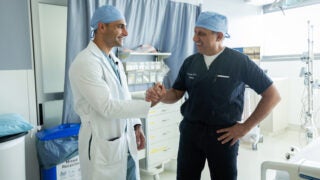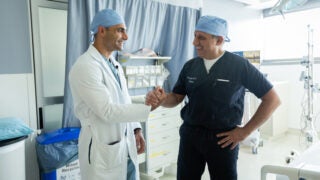Health Sciences Campus getting major revamp
Projects include research, patient and housing facilities as well as improved sidewalks and landscaping
USC’s Health Sciences Campus — home of the university’s two hospitals and medical school, nearly 4,000 staff and faculty and 1,200 students — is undergoing a lot of change.
The 79-acre campus in Boyle Heights, about seven miles from the University Park Campus, has 70 construction projects under its belt — the most since it opened in 1952.
The overall goal, envisioned by USC President C. L. Max Nikias and the school’s master plan, is to give the campus more of a “university feel” to match University Park, with enhanced entrances, wider sidewalks, new lampposts and lusher landscaping, not to mention state-of-the-art research and patient facilities.
While the campuses differ architecturally — many HSC buildings used to belong to the county — the work will remind you you’re at the University of Southern California when you enter the Health Sciences Campus.
“This was the vision of our president to unite the two campuses, making the Health Sciences Campus identifiable as part of the USC whole,” said Joe Back, associate senior vice president of Campus Development and Facilities Management.
Since 70 is a big number, we’ve highlighted seven of the most noticeable changes coming to HSC:
• A new medical office building
Norris Healthcare Consultation, at the corner of Alcazar and San Pablo streets, will house medical offices adjacent to USC Norris Cancer Hospital, similarly focused on cancer treatment. It’s the first building of its kind in more than a decade, offering the region’s first comprehensive multiple sclerosis clinic, infusion therapy, outpatient surgery center and a women’s cancer program. There will also be dining options. It’s about half finished and is expected to open next summer.
• State-of-the-art Stevens Hall
Stevens Hall (formerly Raulston Memorial Research Building), the oldest building at HSC, was completely re-done from the ground up and is a shining standout in the work going on all over HSC. Now known as the Mark and Mary Stevens Neuroimaging and Informatics Institute, the institute will hold more than 100 faculty and staff dedicated to fields such as neuroscience and biology — led by Arthur Toga and Paul Thompson, who pioneered research in the spread of Alzheimer’s disease and the brain mapping of neurological disease.
Opening in August, it features a magnetic resonance imaging lab and a theater-like conference room with video screens that span a floor-to-ceiling wall.
“This building is as state-of-the-art as they come,” said Robert Scrofano, director of capital construction at the campus.
• More parking
A 300-car surface lot is coming to North Soto and Norfolk streets, across from Hazard Park. The lot will offer hourly rate parking and be finished in September.
• Wider, nicer sidewalks
The sidewalks around HSC used to be so narrow two people couldn’t even walk side by side. Thanks to the wider sidewalks — complete with brick ribboning and landscaping — doctors, students and patients won’t have to walk single-file around campus and can chat as they stroll. About a quarter of the work is done. There are also 265 lightposts being installed.
• More trees
HSC is getting 350 additional trees — oaks and magnolias — all over campus.
• Student housing
Currie Hall, a housing development of 178 units to open in August, is already booked up. The residential development offers private bedrooms and bathrooms with shared communal spaces. There’s also a child care center that can accommodate more than 100 kids. This is a big boon for the students at the campus, where housing previously was limited to Seaver Residence Hall, with about 90 beds.
• A new hotel
Hyatt is planning to open a hotel on campus to accommodate the many patients that travel from afar to be treated at the USC hospitals. There are plans for 14,000 square feet of retail and restaurant space and 10,000 square feet of conference space. It’s tentatively planned to be open by 2018.



